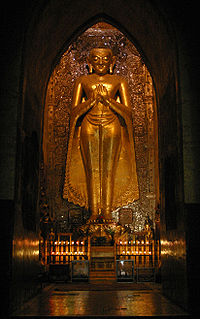- Kassapa Buddha
-
This article is about Kashyapa Buddha, the ancient buddha. For more information on the Hindu sage Kashyapa, see Kashyapa. See also and Mahakasyapa information on the Buddhist monk.
Kassapa Buddha 
Ananda Temple BuddhaSanskrit: Kasyapa Buddha Pāli Kassapa Buddha Burmese: ကဿပ ([kaʔθəpa̰]) Chinese: 迦葉佛 Mongolian: ᠭᠡᠷᠡᠯ ᠰᠠᠬᠢᠭᠴᠢ, Гашив, (Geshib) Tibetan: འོད་སྲུང་ཆེན་པོ (Ösung Chenpo) Sinhala: කස්සප බුද්ධ Information Venerated by: Theravada, Mahayana, Vajrayana Preceded By: Koṇāgamana Buddha Succeeded By: Gautama Buddha Part of a series on
Buddhism
Dharma or concepts
Four Noble Truths
Five Aggregates
Impermanence
Suffering · Non-self
Dependent Origination
Middle Way · Emptiness
Karma · Rebirth
Samsara · CosmologyPractices
Three Jewels
Noble Eightfold Path
Morality · Perfections
Meditation · Mindfulness
Wisdom · Compassion
Aids to Enlightenment
Monasticism · LaityNirvāṇa
Four Stages · Arahant
Buddha · BodhisattvaTraditions · Canons
Theravāda · Pali
Mahāyāna · Chinese
Vajrayāna · TibetanIn Buddhist tradition, Kassapa (Pāli) is the name of a Buddha, the third of the five Buddhas of the present kalpa (the Bhaddakappa or 'Fortunate Aeon'), and the sixth of the six Buddhas prior to the historical Buddha mentioned in the earlier parts of the Pali Canon (D.ii.7). In the Buddhist texts in Sanskrit, this Buddha is known as Kāśyapa.
Contents
Life
Kassapa was born in Nepal. His parents were the Brahmins Brahmadatta and Dhanavatī, of the Kassapagotta.
According to legend, his body was twenty cubits high, and he lived for two thousand years in three different palaces. They are Hamsa, Yasa, and Sirinanda. (The BuA.217 calls the first two palaces Hamsavā and Yasavā). His chief wife was Sunandā, who bore him a son named Vijitasena.
Kassapa gave up his worldly life traveling in his palace (pāsāda). He practiced austerities for only seven days. Just before attaining enlightenment, he accepted a meal of milk-rice from his wife and grass for his seat from a yavapālaka named Soma. His bodhi (the tree under which he attained enlightenment) was a banyan tree, and he preached his first sermon at Isipatana to an assembly of monks who had renounced the world in his company.
Kassapa performed the Twin Miracle at the foot of an asana tree outside Sundar Nagar, India. He held only one assembly of his disciples; among his most famous conversions was that of Nāradeva, a Yaksha. His chief disciples among monks were Tissa and Bhāradvāja, and among nuns were Anulā and Uruvelā, his constant attendant being Sabbamitta. Among his patrons, the most eminent were Sumangala and Ghattīkāra, Vijitasenā, and Bhaddā.
Kassapa died at the age of forty thousand years, in the city of Kashi, in the Kasi Kingdom (now known as Varanasi, in the modern-day Indian state of Uttar Pradesh. Over his relics was raised a thūpa one league in height, each brick of which was worth one crore (ten million) rupees.
The Stupa of Kassapa Buddha
There was initially a great difference of opinion on what should be the size of the stupa and of what material it should be built. Construction of the stupa was begun after these issues were finally settled. But then the citizens found they lacked sufficient funds to complete the stupa. An anāgāmī devotee named Sorata travelled throughout Jambudipa, requesting money from the people for the completion of the stupa. He sent the money as he received it, and on hearing that the work was completed, he set out to go and worship the stupa. However, he was seized by robbers and murdered in the forest, which later came to be known as the Andhavana.
Upavāna, in a previous birth, became the guardian deity of the stupa, hence his great majesty in his last life (DA.ii.580; for another story of the building of the shrine see DhA.iii.29).
Among the thirty-seven goddesses noticed by Guttila when he visited heaven was one who had offered a scented five-spray at the stupa (J.ii.256). Alāta offered āneja-flowers and obtained a happy rebirth (J.vi.227).
The cause of Mahā-Kaccāna's golden complexion was his gift of a golden brick to the building of Kassapa's shrine (AA.i.116). At the same stupa, Anuruddha, who was then a householder in Benares, offered butter and molasses in bowls of brass, which were placed without any interval around the stupa (AA.i.105).
References
See also
The other four Buddhas of the present kalpa:
- Kakusandha Buddha
- Konagamana Buddha
- Gautama Buddha
- Maitreya Buddha
- List of the twenty-eight Buddhas
Buddhist titles Preceded by
Koṇāgamana BuddhaSeven Buddhas of the Past Succeeded by
Śākyamuni BuddhaCategories:- Buddhas
Wikimedia Foundation. 2010.

